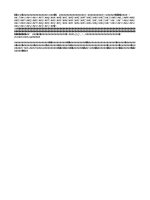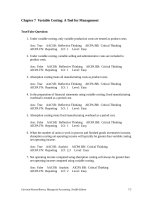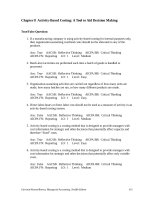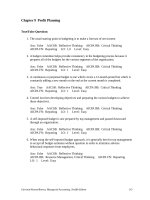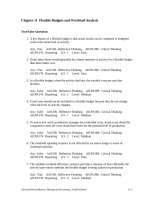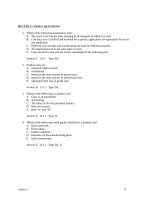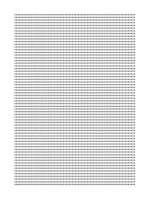Test bank managerial accounting by hilton 9e chapter05
Bạn đang xem bản rút gọn của tài liệu. Xem và tải ngay bản đầy đủ của tài liệu tại đây (161.14 KB, 34 trang )
MULTIPLE CHOICE QUESTIONS
1. Consider the following statements regarding traditional costing systems:
I.Overhead costs are applied to products on the basis of volume-related measures.
II.All manufacturing costs are easily traceable to the goods produced.
III.Traditional costing systems tend to distort unit manufacturing costs when numerous goods are
made that have widely varying production requirements.
Which of the above statements is (are) true?
A. I only.
B. II only.
C. III only.
D. I and III.
E. II and III.
Answer: D LO: 1 Type: N
2. Many traditional costing systems:
A. trace manufacturing overhead to individual activities and require the development of
numerous activity-costing rates.
B. write off manufacturing overhead as an expense of the current period.
C. combine widely varying elements of overhead into a single cost pool.
D. use a host of different cost drivers (e.g., number of production setups, inspection hours,
orders processed) to improve the accuracy of product costing.
E. produce results far superior to those achieved with activity-based costing.
Answer: C LO: 1 Type: N
3. The following tasks are associated with an activity-based costing system:
1—Calculation of cost application rates
2—Identification of cost drivers
3—Assignment of cost to products
4—Identification of cost pools
Which of the following choices correctly expresses the proper order of the preceding tasks?
A. 1, 2, 3, 4.
B. 2, 4, 1, 3.
C. 3, 4, 2, 1.
D. 4, 2, 1, 3.
E. 4, 2, 3, 1.
Answer: D LO: 2, 4 Type: RC
Chapter 5
109
4. Which of the following is the proper sequence of events in an activity-based costing system?
A. Identification of cost drivers, identification of cost pools, calculation of cost application rates,
assignment of cost to products.
B. Identification of cost pools, identification of cost drivers, calculation of cost application rates,
assignment of cost to products.
C. Assignment of cost to products, identification of cost pools, identification of cost drivers,
calculation of cost application rates.
D. Calculation of cost application rates, identification of cost drivers, identification of cost
pools, assignment of cost to products.
E. Some other sequence of the four activities listed above.
Answer: B LO: 2, 4 Type: RC
5. Which of the following tasks is not normally associated with an activity-based costing system?
A. Calculation of cost application rates.
B. Identification of cost pools.
C. Preparation of allocation matrices.
D. Identification of cost drivers.
E. Assignment of cost to products.
Answer: C LO: 2, 4 Type: RC
6. Which of the following is not a broad, cost classification category typically used in activity-based
costing?
A. Unit-level.
B. Batch-level.
C. Product-sustaining level.
D. Facility-level.
E. Management-level.
Answer: E LO: 3 Type: RC
7. In an activity-based costing system, direct materials used would typically be classified as a:
A. unit-level cost.
B. batch-level cost.
C. product-sustaining cost.
D. facility-level cost.
E. matrix-level cost.
Answer: A LO: 3 Type: N
8. Which of the following is least likely to be classified as a batch-level activity in an activity-based
costing system?
A. Shipping.
B. Receiving and inspection.
C. Production setup.
D. Property taxes.
E. Quality assurance.
110
Hilton, Managerial Accounting, Seventh Edition
Answer: D LO: 3 Type: RC
Chapter 5
111
9. In an activity-based costing system, materials receiving would typically be classified as a:
A. unit-level activity.
B. batch-level activity.
C. product-sustaining activity.
D. facility-level activity.
E. period-level activity.
Answer: B LO: 3 Type: RC
10. Foster, Inc., an appliance manufacturer, is developing a new line of ovens that uses controlledlaser technology. The research and testing costs associated with the new ovens is said to arise
from a:
A. unit-level activity.
B. batch-level activity.
C. product-sustaining activity.
D. facility-level activity.
E. competitive-level activity.
Answer: C LO: 3 Type: N
11. Consider the following statements regarding product-sustaining activities:
I.They must be done for each batch of product that is made.
II.They must be done for each unit of product that is made.
III.They are needed to support an entire product line.
Which of the above statements is (are) true?
A. I only.
B. II only.
C. III only.
D. I and II.
E. II and III.
Answer: C LO: 3 Type: RC
12. Which of the following is least likely to be classified as a facility-level activity in an activitybased costing system?
A. Plant maintenance.
B. Property taxes.
C. Machine processing cost.
D. Plant depreciation.
E. Plant management salaries.
Answer: C LO: 3 Type: RC
112
Hilton, Managerial Accounting, Seventh Edition
13. The salaries of a manufacturing plant's management are said to arise from:
A. unit-level activities.
B. batch-level activities.
C. product-sustaining activities.
D. facility-level activities.
E. direct-cost activities.
Answer: D LO: 3 Type: RC
14. Which of the following choices correctly depicts a cost that arises from a
batch-level activity and one that arises from a facility-level activity?
Batch-Level
Facility-Level
Activity
Activity
A. Direct materials
Plant depreciation
B. Inspection
Property taxes
C. Quality assurance
Shipping
D. Plant maintenance
Insurance
E. Management salaries
Material handling
Answer: B LO: 3 Type: RC
15. The division of activities into unit-level, batch-level, product-sustaining level, and facility-level
categories is commonly known as a cost:
A. object.
B. application method.
C. hierarchy.
D. estimation method.
E. classification scheme that is useful in traditional, volume-based systems.
Answer: C LO: 3 Type: RC
16. Alamo's customer service department follows up on customer complaints by telephone inquiry.
During a recent period, the department initiated 7,000 calls and incurred costs of $203,000. If
2,940 of these calls were for the company's wholesale operation (the remainder were for the retail
division), costs allocated to the retail division should amount to:
A. $0.
B. $29.
C. $85,260.
D. $117,740.
E. $203,000.
Answer: D LO: 4 Type: A
Chapter 5
113
Use the following to answer questions 17-18:
Riverside Florists uses an activity-based costing system to compute the cost of making floral bouquets
and delivering the bouquets to its commercial customers. Company personnel who earn $180,000
typically perform both tasks; other firm-wide overhead is expected to total $70,000. These costs are
allocated as follows:
Wages and salaries
Other overhead
Bouquet
Production
60%
50%
Delivery
30%
35%
Other
10%
15%
Riverside anticipates making 20,000 bouquets and 4,000 deliveries in the upcoming year.
17. The cost of wages and salaries and other overhead that would be charged to each bouquet made
is:
A. $7.15.
B. $8.75.
C. $12.50.
D. $13.75.
E. some other amount.
Answer: A LO: 4 Type: A
18. The cost of wages and salaries and other overhead that would be charged to each delivery is:
A. $19.63.
B. $20.31.
C. $26.75.
D. $40.63.
E. some other amount.
Answer: A LO: 4 Type: A
114
Hilton, Managerial Accounting, Seventh Edition
Use the following to answer questions 19-27:
HiTech Products manufactures three types of remote-control devices: Economy, Standard, and Deluxe.
The company, which uses activity-based costing, has identified five activities (and related cost drivers).
Each activity, its budgeted cost, and related cost driver is identified below.
Activity
Material handling
Material insertion
Automated machinery
Finishing
Packaging
Total
Cost
$ 225,000
2,475,000
840,000
170,000
170,000
$3,880,000
Cost Driver
Number of parts
Number of parts
Machine hours
Direct labor hours
Orders shipped
The following information pertains to the three product lines for next year:
Units to be produced
Orders to be shipped
Number of parts per unit
Machine hours per unit
Labor hours per unit
Economy
10,000
1,000
10
1
2
Standard
5,000
500
15
3
2
Deluxe
2,000
200
25
5
2
19. What is HiTech's cost application rate for the material-handling activity?
A. $1.00 per part.
B. $2.25 per part.
C. $6.62 per labor hour.
D. $13.23 per part.
E. A rate other than those listed above.
Answer: A LO: 4 Type: A
20. What is HiTech's cost application rate for the automated machinery activity?
A. $24.00 per machine hour.
B. $24.50 per labor hour.
C. $49.42 per unit.
D. $50.00 per machine hour.
E. A rate other than those listed above.
Answer: A LO: 4 Type: A
21. What is HiTech's cost application rate for the finishing activity?
A. $5.00 per labor hour.
B. $5.00 per machine hour.
C. $5.00 per unit.
D. $7.50 per unit.
E. A rate other than those listed above.
Answer: A LO: 4 Type: A
Chapter 5
115
116
Hilton, Managerial Accounting, Seventh Edition
22. What is HiTech's cost application rate for the packaging activity?
A. $4.86 per machine hour.
B. $5.00 per labor hour.
C. $10.00 per unit.
D. $100.00 per order shipped.
E. A rate other than those listed above.
Answer: D LO: 4 Type: A
23. Under an activity-based costing system, what is the per-unit cost of Economy?
A. $141.
B. $164.
C. $225.
D. $228.
E. An amount other than those listed above.
Answer: B LO: 4 Type: A
24. Under an activity-based costing system, what is the per-unit cost of Standard?
A. $164.
B. $228.
C. $272.
D. $282.
E. An amount other than those listed above.
Answer: C LO: 4 Type: A
25. Under an activity-based costing system, what is the per-unit cost of Deluxe?
A. $272.
B. $282.
C. $320.
D. $440.
E. An amount other than those listed above.
Answer: D LO: 4 Type: A
26. Assume that HiTech is using a volume-based costing system, and the preceding manufacturing
costs are applied to all products based on direct labor hours. How much of the preceding cost
would be assigned to Deluxe?
A. $456,471.
B. $646,471.
C. $961,176.
D. $1,141,176.
E. An amount other than those listed above.
Answer: A LO: 1 Type: A
Chapter 5
117
27. Assume that HiTech is using a volume-based costing system, and the preceding manufacturing
costs are applied to all products based on direct labor hours. How much of the preceding cost
would be assigned to Standard?
A. $456,471.
B. $646,471.
C. $961,176.
D. $1,141,176.
E. An amount other than those listed above.
Answer: D LO: 1 Type: A
Use the following to answer questions 28-31:
Century, Inc., currently uses traditional costing procedures, applying $400,000 of overhead to products X
and Y on the basis of direct labor hours. The firm is considering a shift to activity-based costing and the
creation of individual cost pools that will use direct labor hours (DLH), production setups (SU), and
number of parts components (PC) as cost drivers. Data on the cost pools and respective driver volumes
follow.
Product
X
Y
Pool No. 1
(Driver: DLH)
600
1,400
Pool No. 2
(Driver: SU)
30
50
Pool No. 3
(Driver: PC)
1,500
1,000
Pool Cost
$80,000
$140,000
$180,000
28. The overhead cost allocated to product X by using traditional costing procedures would be:
A. $120,000.
B. $184,500.
C. $215,500.
D. $280,000.
E. some other amount.
Answer: A LO: 1 Type: A
29. The overhead cost allocated to product Y by using traditional costing procedures would be:
A. $120,000.
B. $184,500.
C. $215,500.
D. $280,000.
E. some other amount.
Answer: D LO: 1 Type: A
118
Hilton, Managerial Accounting, Seventh Edition
30. The overhead cost allocated to product X by using activity-based costing procedures would be:
A. $120,000.
B. $184,500.
C. $215,500.
D. $280,000.
E. some other amount.
Answer: B LO: 4 Type: A
31. The overhead cost allocated to product Y by using activity-based costing procedures would be:
A. $120,000.
B. $184,500.
C. $215,500.
D. $280,000.
E. some other amount.
Answer: C LO: 4 Type: A
Use the following to answer questions 32-33:
Kelly and Logan, an accounting firm, provides consulting and tax planning services. A recent analysis
found that 65% of the firm's billable hours to clients resulted from tax planning and for many years, the
firm's total administrative cost (currently $250,000) has been allocated to services on this basis.
The firm, contemplating a change to activity-based costing, has identified three components of
administrative cost, as follows:
Staff support
In-house computing charges
Miscellaneous office costs
Total
$180,000
50,000
20,000
$250,000
A recent analysis of staff support found a strong correlation with the number of clients served (consulting,
20; tax planning, 60). In contrast, in-house computing and miscellaneous office cost varied directly with
the number of computer hours logged and number of client transactions, respectively. Consulting
consumed 30% of the firm's computer hours and had 20% of the total client transactions.
32. Assuming the use of activity-based costing, the proper percentage to use in allocating staff
support costs to tax planning services is:
A. 20%.
B. 60%.
C. 65%.
D. 75%.
E. 80%.
Answer: D LO: 4 Type: A
Chapter 5
119
33. If Kelly and Logan switched from its current accounting method to an activity-based costing
system, the amount of administrative cost chargeable to consulting services would:
A. decrease by $23,500.
B. increase by $23,500.
C. decrease by $32,500.
D. change by an amount other than those listed above.
E. change, but the amount cannot be determined based on the information presented.
Answer: A LO: 1, 4 Type: A
34. Activity-based costing systems:
A. use a single, volume-based cost driver.
B. assign overhead to products based on the products' relative usage of direct labor.
C. often reveal products that were under- or overcosted by traditional costing systems.
D. typically use fewer cost drivers than more traditional costing systems.
E. have a tendency to distort product costs.
Answer: C LO: 5 Type: RC
35. Dreyfus Manufacturing sells a number of goods whose selling price is heavily influenced by cost.
A recent study of product no. 519 revealed a traditionally-derived total cost of $1,019, a selling
price of $1,850 based on that figure, and a newly computed activity-based total cost of $1,215.
Which of the following statements is true?
A. All other things being equal, the company should consider a drop in its sales price.
B. The company may have been extremely competitive in the marketplace from a price
perspective.
C. Product no. 519 could be labeled as being overcosted by the firm's traditional costing
procedures.
D. If product no. 519 is undercosted by traditional accounting procedures, then all of the
company's other products must be undercosted as well.
E. Generally speaking, the activity-based cost figure is “less accurate” than the traditionallyderived cost figure.
Answer: B LO: 5 Type: N
36. Vanguard combines all manufacturing overhead into a single cost pool and allocates this overhead
to products by using machine hours. Activity-based costing would likely show that with
Vanguard's current procedures,
A. all of the company's products are undercosted.
B. the company's high-volume products are undercosted.
C. all of the company's products are overcosted.
D. the company's high-volume products are overcosted.
E. the company's low-volume products are overcosted.
Answer: D LO: 5 Type: N
120
Hilton, Managerial Accounting, Seventh Edition
37. Jackson manufactures products X and Y, applying overhead on the basis of
labor hours. X, a low-volume product, requires a variety of complex
manufacturing procedures. Y, on the other hand, is both a high-volume
product and relatively simplistic in nature. What would an activity-based
costing system likely disclose about products X and Y as a result of Jackson's
current accounting procedures?
X
Y
A. Undercosted
Undercosted
B. Undercosted
Overcosted
C. Overcosted
Undercosted
D. Overcosted
Overcosted
E. Costed correctly
Costed correctly
Answer: B LO: 5 Type: RC
38. Koski manufactures products J and K, applying overhead on the basis of labor
hours. J, a low-volume product, requires a variety of complex manufacturing
procedures. K, on the other hand, is both a high-volume product and
relatively simplistic in nature. What would an activity-based costing system
likely disclose about products J and K as a result of Koski's current accounting
procedures?
Undercosted
Overcosted
A.
J, K
B.
J, K
C.
J
K
D.
K
J
E. None of the above, as both products are costed correctly.
Answer: C LO: 5 Type: RC
39. Consider the following statements:
I.Product diversity creates costing problems because diverse products tend to utilize
manufacturing activities in different ways.
II.Overhead costs that are not incurred at the unit level create costing problems because such
costs do not vary with traditional application bases such as direct labor hours or machine
hours.
III.Product diversity typically exists when a single product (e.g., a ballpoint pen) is made in
different colors.
Which of the above statements is (are) true?
A. I only.
B. II only.
C. I and II.
D. I and III.
E. II and III.
Answer: C LO: 5 Type: RC
Chapter 5
121
40. Consumption ratios are useful in determining:
A. the existence of product-line diversity.
B. overhead that is incurred at the unit level.
C. if overhead-producing activities are being utilized effectively.
D. if overhead costs are being applied to products.
E. if overhead-producing activities are being utilized efficiently.
Answer: A LO: 5 Type: RC
41. Widely varying consumption ratios:
A. are reflective of product-line diversity.
B. indicate an out-of-control production environment.
C. dictate a need for traditional costing systems.
D. work against the implementation of activity-based costing.
E. create an unsolvable product-costing problem.
Answer: A LO: 5 Type: RC
42. Moon Bay Manufacturing uses machine hours to apply manufacturing overhead to products. This
method of costing would likely be acceptable if the company has:
A. a large proportion of unit-level activities.
B. a large proportion of unit-level activities and fairly identical consumption ratios among
product lines.
C. a large proportion of unit-level activities and widely varying consumption ratios among
product lines.
D. a large proportion of nonunit-level activities.
E. a large proportion of nonunit-level activities and fairly identical consumption ratios among
product lines.
Answer: B LO: 5 Type: N
43. In comparison with a system that uses a single, volume-based cost driver, an activity-based
costing system is preferred when a company has:
A. a large proportion of nonunit-level activities.
B. product-line diversity or a large proportion of nonunit-level activities.
C. minimal product-line diversity and a small proportion of nonunit-level activities.
D. existing variances from budgeted amounts.
E. a situation other than those noted above.
Answer: B LO: 5 Type: RC
122
Hilton, Managerial Accounting, Seventh Edition
44. Consider the following factors:
I.The degree of correlation between consumption of an activity and consumption of a particular
cost driver.
II.The likelihood that a particular cost driver will induce a desired behavioral effect.
III.The likelihood that a particular cost driver will cause an increase in the cost of measurement.
Which of these factors should be considered in the selection of a cost driver?
A. I only.
B. I and II.
C. I and III.
D. II and III.
E. I, II, and III.
Answer: E LO: 6 Type: RC
45. Which of the following activity cost pools and activity measures likely has the
lowest degree of correlation?
Activity Cost Pool
Activity Measure
A. Order department
Number of orders processed
B. Sales management
Time spent by managers in each sales territory
C. Accounts receivable processing
Number of customers
D. Catering
Numbers of meals served
E. Employee travel to job sites (sites are
Number of employees
within 100-mile radius of company
headquarters)
Answer: E LO: 6 Type: N
46. Grossman Enterprises is converting to an activity-based costing system and needs to depict the
various activities in its manufacturing process along with the activities' relationships. Which of
the following is a possible tool that the company can use to accomplish this task?
A. Storyboards.
B. Activity relationship charts (ARCs).
C. Decision trees.
D. Simulation games.
E. Process organizers.
Answer: A LO: 7 Type: RC
Chapter 5
123
47. Successful adoptions of activity-based costing typically occur when companies rely heavily on:
A. finance personnel.
B. accounting personnel.
C. manufacturing personnel.
D. office personnel.
E. multidisciplinary project teams.
Answer: E LO: 7 Type: RC
48. Under a traditional costing system, which of the following costs would likely be classified as
indirect with respect to the various products manufactured?
A. Plant maintenance.
B. Factory supplies.
C. Utilities.
D. Machinery depreciation.
E. All of the above would be considered indirect costs.
Answer: E LO: 7 Type: N
49. Williams Corporation is changing from a traditional costing system to an activity-based system.
As a result of this action, which of the following costs would likely change from indirect to
direct?
A. Direct materials.
B. Factory supplies.
C. Production setup.
D. Production setup and finished-goods inspection.
E. Production setup, finished-goods inspection, and product shipping.
Answer: E LO: 7 Type: N
50. Which of the following generally fails to signal the need for a new product-costing system?
A. Line managers do not believe reported product costs.
B. Complex products have high reported profitability despite the lack of premium prices.
C. Overhead rates are high and increasing over time.
D. Line managers suggest that seemingly profitable products be dropped.
E. Product-line profit margins are easy to explain.
Answer: E LO: 7 Type: RC
51. Of the following organizations, activity-based costing cannot be used by:
A. manufacturers.
B. financial-services firms.
C. book publishers.
D. hotels.
E. none of the above, as all are able to use this costing system.
Answer: E LO: 8 Type: RC
124
Hilton, Managerial Accounting, Seventh Edition
52. Which of the following statements about activity-based costing (ABC) is false?
A. ABC cannot be used by service businesses.
B. In comparison with traditional costing systems, ABC tends to use more cost pools and more
cost drivers.
C. In comparison with traditional-costing systems, ABC results in less cost “averaging” of
various diversified activities.
D. In comparison with traditional-costing systems, ABC results in more costs being classified as
direct costs.
E. ABC tends to reduce cost distortion among product lines.
Answer: A LO: 8 Type: N
53. A hospital administrator is in the process of implementing an activity-based-costing system.
Which of the following tasks would not be part of this process?
A. Identification of cost pools.
B. Calculation of cost application rates.
C. Assignment of cost to services provided.
D. Identification of cost drivers.
E. None of the above, as all these tasks would be part of the process.
Answer: E LO: 8 Type: RC
EXERCISES
Classification of Activities
54. St. Helena Cellars produces wine in northern California. Consider the following selected costs
that arose during the current year:
1.
2.
3.
4.
5.
6.
Safety costs at winery
Truckload shipping costs
Building maintenance costs
Bottle and cork cost
Development cost of new, after-dinner wine
Tasting and testing costs
Required:
A. Briefly distinguish between unit-level and product-sustaining activities.
B. Classify the six costs listed as arising from a unit-level, batch-level, product-sustaining, or
facility-level activity.
LO: 3 Type: RC, N
Chapter 5
125
Answer:
A. A unit-level activity is performed for each unit of production. In contrast, a productsustaining activity is needed to support an entire product line. The latter is not
necessarily performed each time a new unit or batch of products is manufactured.
B.
1.
2.
3
.
4
.
5
.
6.
Facility-level
Batch-level
Facility-level
Unit-level
Product-sustaining
Batch-level
Classification of Activities
55. Consider the following costs that relate to a bank and a manufacturer of software:
Bank
1. Review cost of commercial loan applications
2. Operating cost of human resources department
3. Immediate processing cost of a specific customer's cash deposit
4. Bank membership cost of joining local Chamber of Commerce
Software manufacturer
5. Label and packaging charges from a commercial printer for a new software release
6. Air conditioning/heating costs of the firm's production plant
7. Transport cost of moving the CD-output from production run no. 1 to the company's
warehouse
8. Design, development, and coding cost of new spreadsheet software
Required:
A. Classify the eight costs listed as arising from either a unit-level, batch-level, productsustaining, or facility-level activity.
B. Would number of loan applications or number of customers be a more appropriate cost-driver
base for the review of loan applications? Briefly explain.
LO: 3, 6 Type: RC, N
Answer:
A. 1. Unit-level
2. Facility-level
3. Unit-level
4. Facility-level
B.
126
5.
6.
7.
8.
Product-sustaining
Facility-level
Batch-level
Product-sustaining
The number of loan applications would be more appropriate because it has a higher correlation with
the amount of review cost incurred. Applications create review cost; customers, on the other hand,
may not.
Hilton, Managerial Accounting, Seventh Edition
Chapter 5
127
Classification of Activities
56. Alexander Corporation produces flat-screen computer monitors. Consider the following selected
costs that arose during the current year:
1.
2.
3.
4.
5.
6.
7.
Direct materials used: $3,640,000
Plant rent, utilities, and taxes: $1,229,000
New technology design engineering: $2,040,000
Materials receiving: $318,000
Manufacturing-run/set-up charges: $115,000
Equipment depreciation: $92,000
General management salaries: $1,564,000
Required:
A. Briefly distinguish between batch-level and facility-level activities.
B. Determine the cost of the firm's unit-level, batch-level, product-sustaining, and facility-level
activities.
LO: 3 Type: RC, N, A
Answer:
A. A batch-level activity is performed for each batch of products rather than for each unit. In
contrast, a facility-level activity is required for an entire process to occur. Examples of the
latter, which support the organization as a whole, include plant maintenance and property
taxes.
B. Unit-level: $3,640,000 (1)
Batch-level: $318,000 (4) + $115,000 (5) = $433,000
Product-sustaining: $2,040,000 (3)
Facility-level: $1,229,000 (2) + $92,000 (6) + $1,564,000 (7) = $2,885,000
128
Hilton, Managerial Accounting, Seventh Edition
Activity-Based Costing, Traditional Costing
57. The controller for Wolfe Machining has established the following overhead cost pools and cost
drivers:
Overhead Cost Pool
Machine setups
Material handling
Quality control inspection
Other overhead costs
Total
Overhead Cost Pool
Machine setups
Material handling
Quality control
Other overhead
Budgeted
Overhead Cost
$240,000
90,000
48,000
160,000
$538,000
Budgeted Level
for Cost Driver
200 setups
60,000 units
1,200 inspections
20,000 machine hours
Cost Driver
Number of setups
Units of raw material
Number of inspections
Machine hours
Overhead Rate
$1,200 per setup
$1.50 per unit
$40 per inspection
$8 per machine hour
Order no. 715 has the following production requirements:
Machine setups: 7
Raw material: 11,200 units
Inspections: 16
Machine hours: 850
Required:
A. Compute the total overhead that should be assigned to order no. 715 by using activity-based
costing.
B. Suppose that Wolfe were to use a single, predetermined overhead rate based on machine
hours. Compute the rate per hour and the total overhead assigned to order no. 715.
C. Discuss the merits of an activity-based costing system in comparison with a traditional
costing system.
LO: 1, 4, 5 Type: A, N
Chapter 5
129
Answer:
A.
Overhead Cost Pool
Machine setups
Material handling
Quality control
Other overhead costs
Total
Predetermined
Overhead Rate
$1,200 per setup
$1.50 per unit
$40 per inspection
$8 per machine hour
Level of
Cost Driver
7 setups
11,200 units
16 inspections
850 machine hours
Cost
$ 8,400
16,800
640
6,800
$32,640
B
$538,000 20,000 machine hours = $26.90 per hour;
$26.90 per hour x 850 hours = $22,865
C.
Activity-based costing (ABC) uses multiple cost drivers, more closely aligning
individual costs with the factors that are creating them. Traditional systems, in
contrast, use fewer drivers and therefore result in “lumping” of unlike activities
together. The end result is that ABC tends to eliminate the cost distortion that
sometimes arises with traditional systems, more specifically, the under- or overcosting
of products.
Activity-Based Costing: Cost Distortion
58. Academy Enterprises uses a traditional-costing system to estimate quality-control costs for its
PDA product line. Costs are estimated at 32% of direct-labor cost, and direct labor totaled
$548,000 for the quarter just ended. Management is contemplating a change to activity-based
costing, and has established three cost pools: incoming material inspection, in-process inspection,
and final product certification. Number of parts, number of units, and number of orders have
been selected as the respective cost drivers.
The following data show the application rates that have been calculated by the company along
with the quantity of driver units for the PDAs:
Cost Application Rate
$ 0.50 per part
0.10 per unit
110.00 per order
Driver Quantities
14 parts
26,000 units
80 orders
Required:
A. Calculate the quarterly quality-control cost that is allocated to the PDA product line under
Academy’s traditional-costing system.
B. Calculate the quarterly quality-control cost that is allocated to the PDAs if activity-based
costing used.
C. Does the traditional approach under- or overcost the product line? By how much?
LO: 1, 4, 5 Type: A, N
130
Hilton, Managerial Accounting, Seventh Edition
Answer:
A. $548,000 x 32% = $175,360
B. Incoming inspection ($0.50 x 14 x 26,000 = $182,000) + in-process inspection (26,000 x
$0.10 = $2,600) + final certification (80 x $110 = $8,800), which totals $193,400.
C. Traditional costing undercosts the PDAs by $18,040 ($193,400 - $175,360).
Activity-Based Costing: Qualitative Emphasis
59. Star Manufacturing, contemplating the adoption of an activity-based costing system, has
established three activity-cost pools: machine setup, quality assurance, and engineering. These
cost pools, the appropriate cost driver, and the percentage of each cost driver consumed by the
company's products (H15, H16, and H17) follow.
Cost Pool
Machine setup
Quality assurance
Engineering
Cost Driver
Number of setups
Number of inspections
Number of change orders
H15
50%
70%
15%
H16
20%
15%
10%
H17
30%
15%
75%
Estimated costs for these three activities, which account for 80% of the firm's total overhead, are
$400,000, $500,000, and $120,000, respectively. Star currently applies manufacturing overhead
to products on the basis of machine hours.
Required:
A. Will activity-based costing systems require more or fewer cost pools than traditional costing
systems? No explanation is necessary.
B. Calculate the cost of machine setup, quality assurance, and engineering to be charged to
product H17.
C. Consider the company's current overhead application procedure.
1. Is Star emphasizing unit-level activities, batch-level activities, product-sustaining
activities, or facility-level activities? Explain.
2. How accurate will the current costing procedure be given the nature of most of the
company's activities? Briefly discuss.
3. How accurate will the current costing procedure be given the consumption ratios of the
firm? Briefly discuss.
LO: 1, 3, 4, 5 Type: A, N
Chapter 5
131
Answer:
A. More
B.
Machine setup: $400,000 x 30% = $120,000
Quality assurance: $500,000 x 15% = $75,000
Engineering: $120,000 x 75% = $90,000
C.
1.
The company currently applies overhead on the basis of machine hours, therefore
emphasizing unit-level activities. Machine hours are consumed for each unit produced.
2.
The current procedure is probably not very accurate. The majority of Star's overhead
(80%) is created by setups, inspections, and engineering change orders, not machine
hours. In this case, for instance, setups and (likely) inspection are really batch-level
activities whereas engineering costs are caused by product-sustaining activities.
3.
The consumption ratios vary extensively from one product to the next, thus indicating
product diversity. The use of a single driver (machine hours in this case) will not
recognize this diversity and will give rise to cost distortion.
Activity-Based Costing: Analysis Emphasis
60. Kenyon Company produces two products (F56 and F57), applying manufacturing overhead on
the basis of direct labor hours. Anticipated unit production costs (material, labor, and overhead)
and manufacturing volumes are:
F56: 2,000 units, $234
F57: 3,500 units, $271
Kenyon's overhead arises because of various activities, one of which is purchase-order
processing. Budgeted cost for this activity is expected to be $70,000. The firm believes that the
number of purchase orders processed is a key cost driver and expects the following activity for its
products: F56, 10 purchase orders; F57, 40 purchase orders. Kenyon's selling prices are based
heavily on cost.
Required:
A. Activity-based costing (ABC) is said to result in improved costing accuracy when compared
with traditional costing procedures. Briefly explain how this improved accuracy is attained.
B. Compute:
1. the pool application rate for purchase-order processing.
2. the purchase-order processing cost to be charged to one unit of F56.
C. Assume that Kenyon switched to activity-based costing and calculated total unit production
costs as follows: F56, $285; F57, $220.
1. Which of the two products, F56 or F57, was overcosted prior to the change to ABC? No
explanation is necessary.
2. Which of the two products, F56 or F57, may have been less competitive in the
marketplace prior to the change to ABC? Briefly explain.
132
Hilton, Managerial Accounting, Seventh Edition
LO: 1, 4, 5 Type: A, N
Answer:
A. Activity-based costing (ABC) uses multiple cost drivers, more closely aligning
individual costs with the factors that are creating them. Traditional systems, in
contrast, use fewer drivers and therefore result in "lumping" of unlike activities (unitlevel, batch-level, and so forth) together. The end result is that ABC tends to eliminate
the cost distortion that sometimes arises with traditional systems, more specifically, the
under- or overcosting of products. Additionally, the use of multiple cost drivers allows
users to better consider variations in consumption ratios that may exist among product
lines.
B.
1.
2.
$70,000 ÷ (10 + 40) = $1,400 per order
$1,400 x 10 = $14,000; $14,000 ÷ 2,000 units = $7
C.
1.
2.
F57 (traditional, $271 vs. ABC, $220)
F57. Kenyon's selling prices are based heavily on cost. An overcosted product will
result in a higher selling price, which may make the company less competitive.
Activity-Based Costing: Analysis Emphasis
61. Lennox Industries manufactures two products: A and B. A review of the company's accounting
records revealed the following per-unit costs and production volumes:
Production volume (units)
Direct material
Direct labor:
2 hours at $12
3 hours at $12
Manufacturing overhead:
2 hours at $93
3 hours at $93
A
2,500
$ 40
B
5,000
$ 60
24
36
186
279
Manufacturing overhead is currently computed by spreading overhead of $1,860,000 over 20,000
direct labor hours. Management is considering a shift to activity-based costing in an effort to
improve the firm's accounting procedures, and the following data are available:
Cost Pool
Setups
General factory
Machine processing
Cost
$ 240,000
1,500,000
120,000
$1,860,000
Cost Driver
Number of setups
Direct labor hours
Machine hours
Cost Driver Volume
A
B
Total
100
20
120
5,000 15,000
20,000
2,200
800
3,000
Lennox determines selling prices by adding 40% to a product's total cost.
Chapter 5
133
